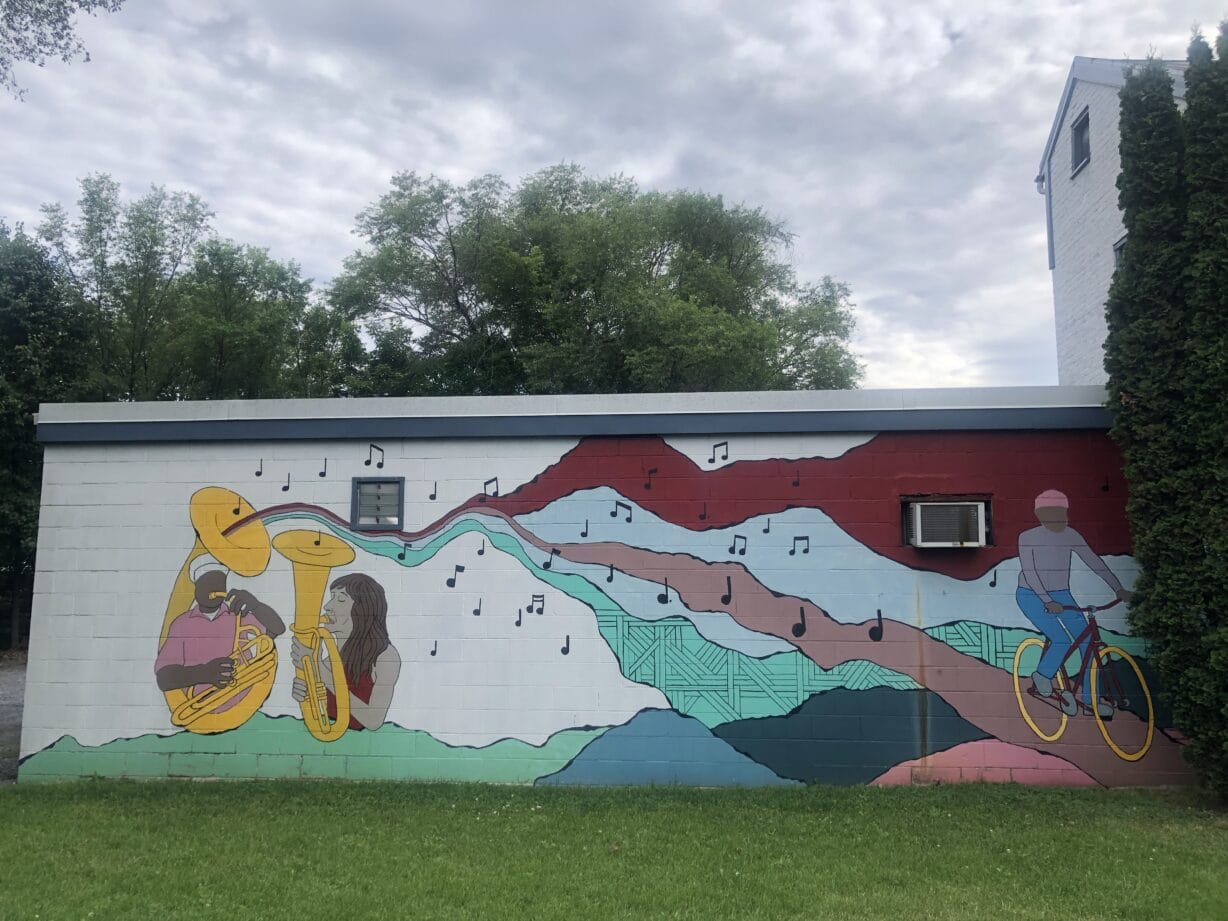
By Sofia Samatar
“The Friendly City” is a weekly column about walking in Harrisonburg that will run during 2024. Each week, your friendly correspondent, writer and teacher Sofia Samatar, will reflect on a walk in our city.
Song of the Open Window
The June heat brings changes to the soundscape of the city. Winter is muffled and still; summer is loud, crackling, brash, and tuneful. Snatches of music blare from car windows, the Doppler effect making ripples of sound in the streets. Walking downtown, we pass a group of vehicles stopped at a redlight, drawn together in a discordant, competitive chorus. Hip-hop beats with Spanish lyrics interweave with melancholy country guitars, the intricate African twang of banjos, the rockslide of heavy metal. When the light changes and the cars move on, they will make their way through neighborhoods where even the flowers seem to announce the arrival of music season: magenta and rust-colored echinacea to keep away summer colds, fragrant elderflower for a throat-soothing cordial, and all the big, showy blooms—sensitive hydrangeas in pink or blue lace, regal ornamental yuccas, the glamorous ivory satin magnolia—that are the divas of the vegetable kingdom.
Ah! how sweet
We have come downtown for a free concert at the Methodist church whose imposing Gothic Revival tower soars above the nearby buildings. Within this somber edifice of dark brown stone, a cheerful crowd has gathered for the noon concert, one of a series that will run all week as part of the annual Shenandoah Valley Bach Festival. The festival offers a good deal more than Bach—during this hour we hear complex, dynamic works by lesser-known composers, a contemporary violin concerto with an ecological theme, a lyrical modern piece that transports us to an imagined seacoast, and a moving interpretation and transformation of the spiritual “Motherless Child.” All at no cost, available at the end of a short walk. One violinist, introducing a series of brief movements, compares it to a box of truffles, offering pleasures to suit every palate: candied canzonetta, piquant scherzo, gooey berceuse. I think of Bach’s comical Coffee Cantata, in which a young caffeine addict enthuses, “Ah! how sweet coffee tastes!” How sweet this music tastes, how delicious it is to be treated to this feast of sound in a church like a candy box with an elegant white lid, where the performers, their instruments polished to a caramel sheen, are surrounded by wood-paneled walls like well-tempered chocolate, poised on a matte red carpet like strawberry fruit leather, and bathed in the reflected light of a magisterial pipe organ that glitters like silver paper.
Sing It Yourself
Walking home, we pass the Court Square Theater, the Friendly City’s independent cinema and performance space. Eraser-pink crests decorate the wall, wheels and grinning animals bearing ornate shields that read RMC, recalling the building’s former life as the Rockingham Motor Company. These emblems work well for a theater, the canine heads like masks, the wheels suggesting the temporal aspect of performance, the curtain’s rise and fall. We remember shows we’ve seen here, projects created by and for the community. There was the play about the traumatic expulsion of families from the mountains in the 1930s, its emotion heightened by the fact that several actors were descended from those families, and by the folk music that filled the stage: square dances, fiddle tunes, gospel melodies. There was a comedy written by a local duo that attracted the city’s punks in droves, so that the theater seemed ready to burst with laughter and black mascara—for the Friendly City is home to a vibrant underground music scene, thriving in basements through the efforts of passionate volunteers. In fact, our city boasts a show house so old—more than thirty years, an astounding length of time in this chancy, irregular subculture—it’s been compared to the Roman Colosseum. (We have heard that this storied venue is about to be shut down, but we can neither confirm nor deny the rumor. To catch what may be the final show at this legendary house, and to learn where its inevitable successor will emerge, you will have to—as the flyers traditionally put it—ask a punk.)
Distant Echoes
If we could, we’d walk to the springs of music scattered throughout the surrounding woods and fields, whose echoes reach us here in the city. We’ve heard reports of a “hootenanny” that regularly takes place in a neighboring forest. Churches ring with Sunday harmonies throughout the valley. As we walk down Main Street, nearing home, a shop sign invites us to “Come in and get geared up for the Red Wing Roots Music Festival,” an annual summer bash in a rural spot we can’t reach on foot, for which, the sign counsels, we will need sunglasses and hats to protect us from the elements, hammocks for sleeping, water bottles for hydration, headlamps to light our way in the dark between the electric, thumping stages, and sandals for dancing. We wish we could walk to the nearby hamlet of Singers Glen, named in honor of the music teacher and publisher Joseph Funk, whose singing schools established a tradition in the region, and whose shape-note hymnal, known as Harmonia Sacra, still draws groups together for a cappella singing.
Resonance Chamber
Who will trace the echo to its source? The whole valley throbs with song. In musical instruments, a hollow resonance chamber amplifies soundwaves. As we reach our house at the bottom of the hill, we wonder if there is something conducive to the production of music in the local geography. Are these mountains the curves of a vast blue instrument? Do we live in a resonance chamber, cupped in a round, reverberant web of tones?
